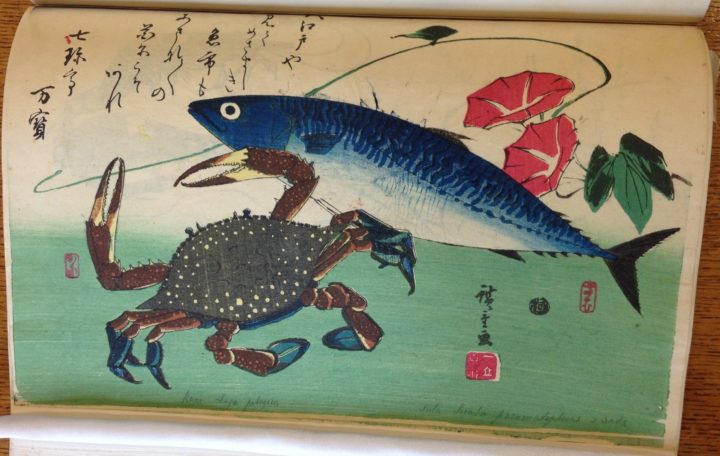7th June 2017: Hiroshige's Fishes
Published on 7th June 2017
As the British Museum celebrates Japanese art with an exhibition focusing on the last 30 years of Hokusai’s life, the Linnean Society Library staff recently rediscovered its own treasure of Japanese art, that of another master, Hiroshige.
Like Hokusai, Utagawa Hiroshige, also Andō Hiroshige (1797–1858), was a Japanese ukiyo-e artist, and is considered the last great master of that tradition. Western artists closely studied Hiroshige's compositions, and some, such as Vincent van Gogh, painted copies of Hiroshige's prints. Hiroshige is best known for his landscapes, and for his depictions of birds and flowers, but between 1832 and 1840 he produced a 'Grand series of fishes' ('Uwo-zukushi'), now quite rare. The series consists of two sets of ten woodblock colour prints of fishes, published around 1832 and 1840.

Seventeen of these 20 prints can be found in albums of animal art collected by German herpetologist and ichthyologist Albert E.L. Günther (1830–1914), held in the Linnean Society collections. Günther, FRS, FLS, was Keeper of Zoology at the Natural History Museum, London, from 1875 to 1895, as well as thirteenth President of the Linnean Society from 1894 to 1900. Günther amassed a major collection of animal art in 39 large volumes of printed illustrations, drawings, photographs and printed ephemera on terrestrial and marine fauna of all regions. As Günther was an ichthyologist (his major work was the Catalogue of Fishes (1859-1870), published by the Ray Society), he collected a large amount of art linked to fishes.
Hiroshige's prints often team fish with plants, and the poetic text surrounding the illustration comments on the seasons and the pleasures found in nature. Hence the print of 'Hirame' and 'Mebaru' (flounder, mebaru and cherry blossom) relates to the month of March: ‘The taste of fish and the sweet smell of blossoms; both reach their peak in the spring.’

For summer, Hiroshige has chosen to depict a crab and a mackerel, accompanied by morning glory: 'The fish market comes to life at dawn like a great morning glory opening up.'

As for October, the plant is a low striped bamboo, and the fishes two gurnards and a right eye flounder. The text reads: 'The flounder are like autumn leaves hanging in the sun near the fisherman's hut.'

Hiroshige's Fishes are rare, and they were later reproduced, copied and reprinted. We would be keen to know more about the Linnean Society woodblocks and we welcome anyone with a knowledge of Japanese art to come and have a look at them and help us uncover more about these prints.
The Library is open Monday to Friday, 10am to 5pm, and accessible to all. It is recommended to contact us before your visit, as the Library is sometimes closed for functions.
Isabelle Charmantier, Deputy Librarian
